Compare Snapdragon 7+ Gen 3 and Snapdragon 8 Gen 2 benchmarks
Qualcomm introduced the new Snapdragon 7+ Gen 3 just a few days ago and OnePlus announced the OnePlus Ace 3V in China with this chipset. Today's article will compare Snapdragon 7+ Gen 3 with Snapdragon 8 Gen 2, a flagship chipset from 2022.
Note : Benchmark tests on OnePlus Ace 3V powered by Snapdragon 7+ Gen 3 and OnePlus 12R powered by Snapdragon 8 Gen 2.
Compare specifications
Before moving forward, let's learn how Snapdragon chipsets are named and see the specs comparison between Snapdragon 7+ Gen 3 and Snapdragon 8 Gen 2.
| Snapdragon 7+ Gen 3 | Snapdragon 8 Gen 2 | |
|---|---|---|
| Release date | March 2024 | November 2022 |
| Node processing | TSMC 4nm | TSMC 4nm |
| CPU | Octa-core Kryo CPU 1x 2.8GHz (Cortex-X4) 4x 2.6GHz (Cortex-A720) 3x 1.9GHz (Cortex-A520) | Octa-core Kryo CPU 1x 3.2GHz (Cortex-X3) 2x 2.8GHz (Cortex-A715) 2x 2.8GHz (Cortex-A710) 3x 2.0GHz (Cortex-A510) |
| GPU | Adreno 732 GPU Super Resolution AFME 2.0 Game Post Processing Accelerator | Adreno 740 GPU Ray Tracing is hardware-accelerated with Unreal Engine 5 Game Post Processing Accelerator |
| NPU | Hexagon NPU Runs AI models on the device | Hexagon NPU |
| Camera support | Cognitive ISP, 3 18-bit ISPs Up to 200MP Bokeh Engine 2.0 Snapdragon Low Light Vision Google Ultra HDR | 18-Bit Spectra ISP Cognitive ISP Snapdragon Sight |
| Connect | Wi-Fi 7, Bluetooth 5.4, LE | Wi-Fi 7, Bluetooth 5.3, LE |
| Modem | Snapdragon X63 5G Modem Peak download speed 4.2 Gbps | Snapdragon X70 5G Modem Peak download speed 10 Gbps |
| Memory/RAM support | UFS 4.0 LPDDR5X memory up to 4200 MHz | UFS 4.0 LPDDR5X memory up to 4200 MHz |
| NavIC support | Have | Have |
| AV1 Decoding | Are not | Have |
Geekbench score 6
First of all, Geekbench 6 was tested on both Snapdragon 7+ Gen 3 and Snapdragon 8 Gen 2 to evaluate their CPU performance. Snapdragon 7+ Gen 3 scored 1,747 points in the single-core test and 4,511 in the multi-core test. For comparison, the Snapdragon 8 Gen 2 scored slightly higher at 1,934 in single-core tasks and 5,367 in multi-threaded tasks.
Even though the Snapdragon 8 Gen 2 has older cores, the high CPU frequency (up to 3.2 GHz) ensures it gets more performance out of the chipset. On the other hand, Snapdragon 7+ Gen 3 clocks up to 2.8 GHz, delivering good performance while maintaining efficiency. For a 7-series chipset to get closer to the flagship 8-series SoC is certainly exciting.
| Geekbench 6 | Snapdragon 7+ Gen 3 | Snapdragon 8 Gen 2 |
|---|---|---|
| Single core | 1,747 | 1,934 |
| Multi-core | 4,511 | 5,367 |
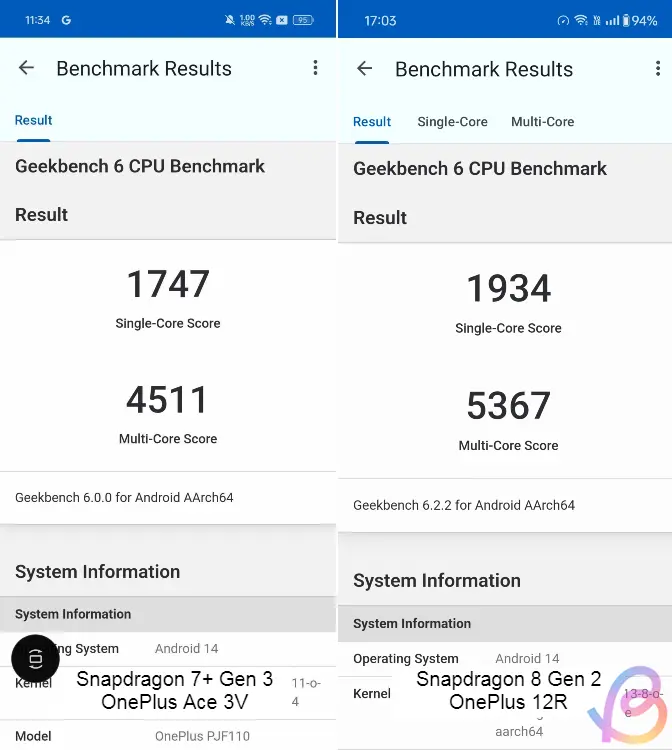
AnTuTu benchmark score
In the AnTuTu benchmark test, Snapdragon 7+ Gen 3 came close to Snapdragon 8 Gen 2. SD 7+ Gen 3 scored 14,56,859 points in the AnTuTu test while SD 8 Gen 2 scored 15,35,770 points. There is only a 5% difference in overall performance. In the CPU test, it was almost on par with the 8 Gen 2.
However, in the GPU test, the Adreno 740 GPU on Snapdragon 8 Gen 2 has a slight lead. But the Adreno 732 GPU on Snapdragon 7 Plus Gen 3 is no less competitive. In the memory test, Snapdragon 7+ Gen 3 performed well when paired with UFS 4.0 storage.
The OnePlus 12R used in this test has older UFS 3.1 storage, which may affect its performance. Both come with LPDDR5X memory. In UX text, both chipsets operate on similar lines.
| AnTuTu Benchmark | Snapdragon 7+ Gen 3 | Snapdragon 8 Gen 2 |
|---|---|---|
| AnTuTu score | 14,56,859 | 15,35,770 |
| CPU | 3,77,796 | 3,88,627 |
| GPU | 4,94,144 | 6,05,405 |
| Memory | 3,24,334 | 2,56,269 |
| UX | 2,60,585 | 2,85,469 |
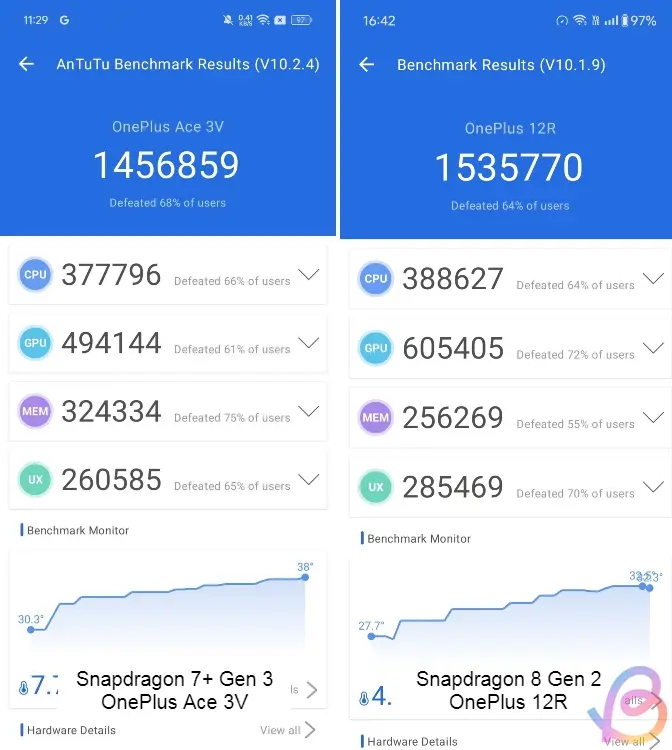
Check CPU Throttling
In the CPU Throttling test, Snapdragon 7+ Gen 3 performed very well. It includes newer, very efficient CPU cores. The SD 7+ Gen 3 accelerated to 84% of maximum performance, showing minimal performance degradation after the 15-minute test. The author of the article ran the test at least 7 times and the results were quite consistent.
The Snapdragon 8 Gen 2 accelerated to 75% of maximum performance, however, it executed more commands in the 15-minute test. Towards the end, the CPU shows a decrease in performance. In terms of efficiency and ability to sustain high CPU pressure, the Snapdragon 7+ Gen 3 performed better than the flagship Snapdragon 8 Gen 2 SoC.
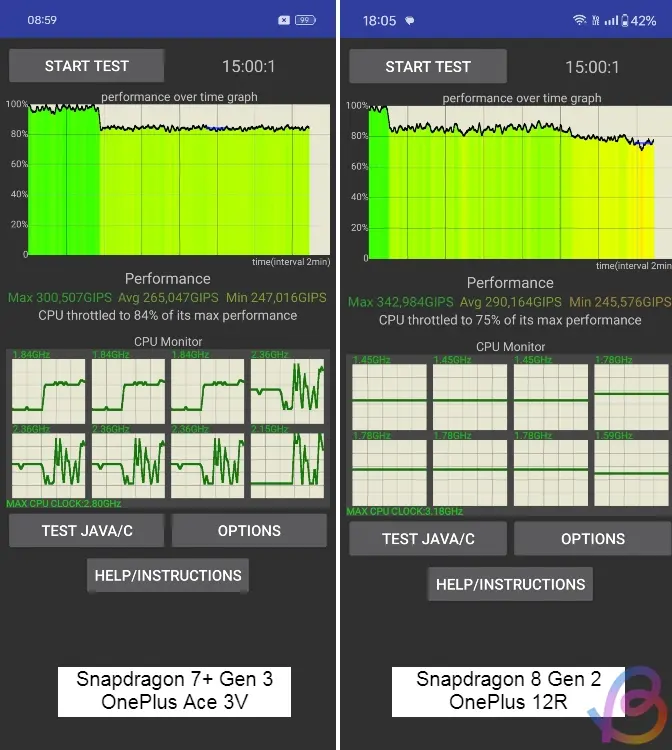
Stresstest 3DMark Wild Life Extreme
To test the GPU's performance, the 3DMark Wild Life Extreme stresstest was run intensively. The Adreno 732 GPU on Snapdragon 7+ Gen 3 has the best loop score of 2,954 and the lowest loop score of 2,476 with a stability of 83.8%.
On the other hand, Snapdragon 8 Gen 2's Adreno 740 GPU achieved the best loop score of 3,738 and the lowest loop score of 2,468 with a stability of 65.9%. The Adreno 740 GPU is actually more powerful, probably due to its higher clock speed. It also has hardware-accelerated Ray Tracing, which the Adreno 732 GPU lacks.
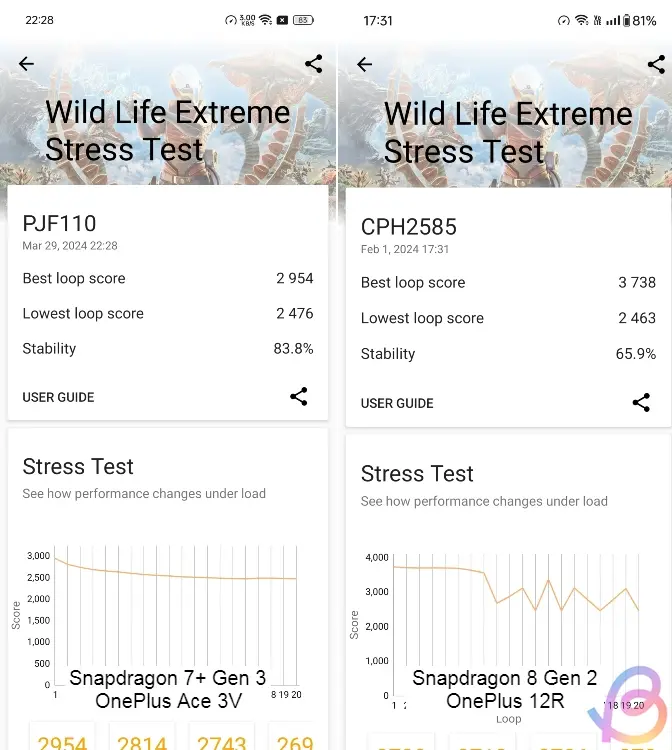
While the Snapdragon 7+ Gen 3 doesn't beat the flagship Adreno 740 GPU on the Snapdragon 8 Gen 2, it has a powerful GPU and is competitive with the top GPUs available today. Solar Bay was not tested because Snapdragon 7+ Gen 3 does not support Ray Tracing.
| Stress Test 3DMark Wild Life Extreme | Snapdragon 7+ Gen 3 | Snapdragon 8 Gen 2 |
|---|---|---|
| Best loop point | 2,954 | 3,738 |
| Lowest loop point | 2,476 | 2,463 |
| Stability | 83.8% | 65.9% |
Test AI performance
Coming to the AI performance test, the author ran the AITuTu benchmark and Snapdragon 7+ Gen 3 and achieved 5,82,942 points. On the contrary, Snapdragon 8 Gen 2 scored almost double the score, i.e. 10,07,228 points. That means the Hexagon NPU is almost twice as powerful as the Hexagon NPU on the Snapdragon 7+ Gen 3.
| Snapdragon 7+ Gen 3 | Snapdragon 8 Gen 2 | |
| AITuTu Score | 5,82,942 | 10,07,228 |
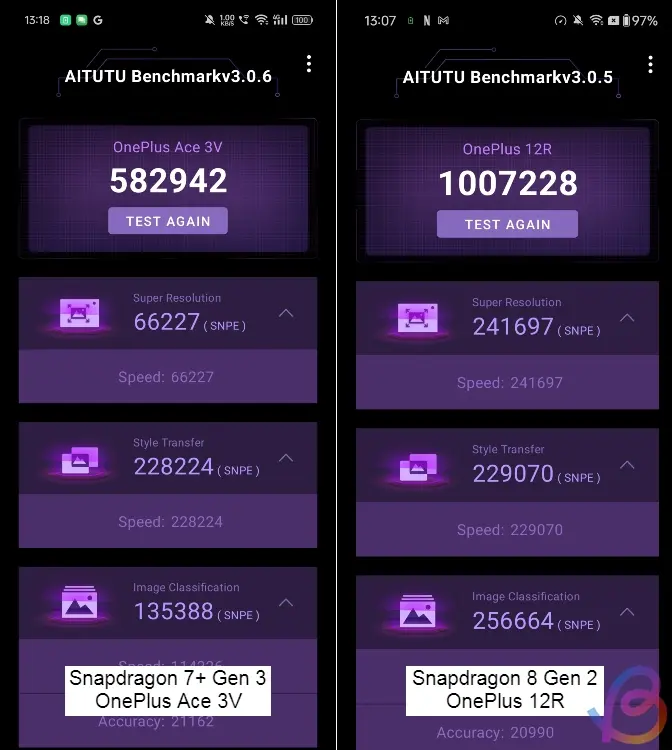
Test 5G speed
Finally, in the 5G speed test, the Snapdragon 8 Gen 2, which has an upgraded Snapdragon X70 5G modem, performed slightly better. It reaches a peak download speed of 394 Mbps and a peak upload speed of 22.3 Mbps.
Meanwhile, the older Snapdragon X63 5G modem on the Snapdragon 7+ Gen 3 achieved download speeds of 382 Mbps and upload speeds of 24.5 Mbps. Both the tests were conducted on Jio's 5G network.
| Test 5G | Snapdragon 7+ Gen 3 | Snapdragon 8 Gen 2 |
|---|---|---|
| Download speed | 382 Mbps | 394 Mbps |
| Upload speed | 24.5 Mbps | 22.3 Mbps |
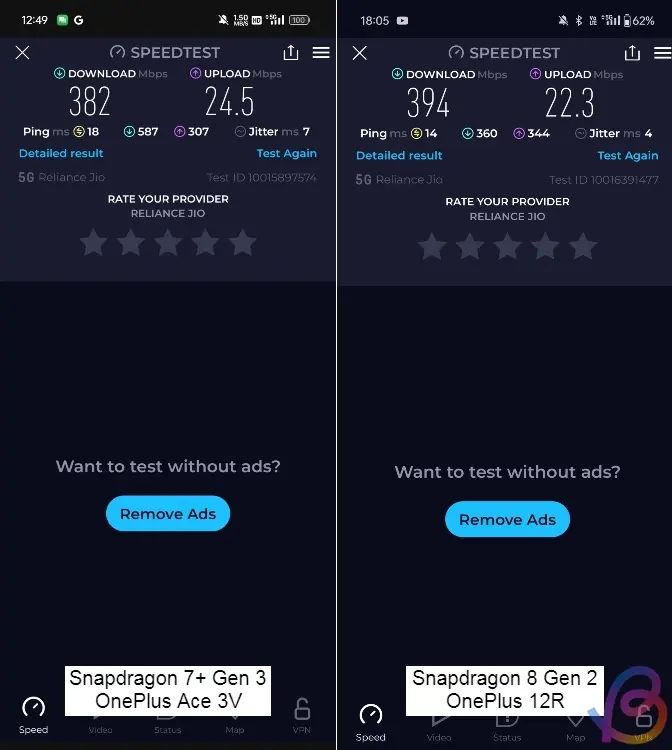
Overall, the Snapdragon 7+ Gen 3 does not beat the Snapdragon 8 Gen 2 in any of the benchmark tests. However, it continues to show that the 7-series chipset can finally compete with older generation flagship SoCs. This makes Snapdragon 7+ Gen 3 an interesting chipset in the mid-range segment.
You should read it
- Learn about Snapdragon microprocessors on smartphones and tablets
- Snapdragon 855 Plus will be a high-end chip, 'special treatment' with very noticeable improvements
- Qualcomm announces the Snapdragon XR2, the heart of future mixed reality headsets
- Will there be Snapdragon X Plus with 5G Modem for Windows?
- Thanks to the Snapdragon 710 chip, there's no need to spend $ 1000 to buy a phone
- Qualcomm shows off the 'superstar' lineup will use the Snapdragon 865
- 5 things to know about Qualcomm Snapdragon 845 chip
- Snapdragon chip increases in price, Android manufacturers 'ruffle their ears'
May be interested
- Will there be Snapdragon X Plus with 5G Modem for Windows?
 previously, there was news that qualcomm is not only launching the snapdragon x elite chipset for windows pcs but is also developing a new variant called 'snapdragon x plus'.
previously, there was news that qualcomm is not only launching the snapdragon x elite chipset for windows pcs but is also developing a new variant called 'snapdragon x plus'. - Thanks to the Snapdragon 710 chip, there's no need to spend $ 1000 to buy a phone
 qualcomm's snapdragon 710 will likely bring major changes in the user's mobile phone selection.
qualcomm's snapdragon 710 will likely bring major changes in the user's mobile phone selection. - Qualcomm shows off the 'superstar' lineup will use the Snapdragon 865
 snapdragon 865 is one of the most powerful 5g chips in the world at the moment.
snapdragon 865 is one of the most powerful 5g chips in the world at the moment. - Learn about Snapdragon 8cx chip, Photoshop and Excel running speed
 the snapdragon 8cx chip is designed to compete with intel's u-series core i5 chips. let's learn about the features of the snapdragon 8cx in the following article with taimienphi.
the snapdragon 8cx chip is designed to compete with intel's u-series core i5 chips. let's learn about the features of the snapdragon 8cx in the following article with taimienphi. - Compare Apple M4 and Snapdragon X Elite
 apple has once again surpassed qualcomm by releasing its latest chipset, the apple m4, before the snapdragon x elite launched. the new apple m4 chipset was introduced alongside the ipad pro oled.
apple has once again surpassed qualcomm by releasing its latest chipset, the apple m4, before the snapdragon x elite launched. the new apple m4 chipset was introduced alongside the ipad pro oled. - 5 things to know about Qualcomm Snapdragon 845 chip
 qualcomm announced the snapdragon 845 at the hawaii tech summit but it wasn't until yesterday that they released details about the new chip.
qualcomm announced the snapdragon 845 at the hawaii tech summit but it wasn't until yesterday that they released details about the new chip. - Snapdragon chip increases in price, Android manufacturers 'ruffle their ears'
 technology blogger digital chat station has just shared an information that attracts a lot of attention about the smartphone market in 2024.
technology blogger digital chat station has just shared an information that attracts a lot of attention about the smartphone market in 2024. - Detecting vulnerabilities in Snapdragon chips allows hackers to penetrate nearly every Android smartphone via wifi
 security researchers have discovered two separate holes on the snapdragon chip that allow hackers to simply connect to the same wi-fi network with their phones or other technology items running the android operating system. occupy device access.
security researchers have discovered two separate holes on the snapdragon chip that allow hackers to simply connect to the same wi-fi network with their phones or other technology items running the android operating system. occupy device access. - Qualcomm launches two new Snapdragon CPU models, promising to stir the market for low-cost ARM laptops
 qualcomm continued to attract attention when it launched two new cpu models designed specifically for arm laptops, namely snapdragon 8c and 7c.
qualcomm continued to attract attention when it launched two new cpu models designed specifically for arm laptops, namely snapdragon 8c and 7c. - Evaluation of Snapdragon 8 Gen 1 in terms of configuration and price
 with a powerful configuration and many improvements in specifications, snapdragon 8+ gen 1 is probably a name that is extremely popular with android users at the present time. see more details of the snapdragon 8 gen 1 review: configuration, price below.
with a powerful configuration and many improvements in specifications, snapdragon 8+ gen 1 is probably a name that is extremely popular with android users at the present time. see more details of the snapdragon 8 gen 1 review: configuration, price below.










 Realme P1 and P1 Pro launched!
Realme P1 and P1 Pro launched! Microsoft adds a page to manage devices sharing the same user account on Windows 11
Microsoft adds a page to manage devices sharing the same user account on Windows 11 Is an Adobe Creative Cloud subscription really worth it if you're not an expert?
Is an Adobe Creative Cloud subscription really worth it if you're not an expert? YouTube is updating its new web interface, users are 'going crazy'
YouTube is updating its new web interface, users are 'going crazy' 6 best calendar sharing apps of 2024
6 best calendar sharing apps of 2024 Telegram has a serious security vulnerability
Telegram has a serious security vulnerability